IS THE PINK PEACOCK REAL? Truth behind Their Existence
Pink peacocks
Vibrant pink A bird with pink feathers associated with fairy tales, animation films, and cartoons is the peacock. It’s a magnificent bird from the virtual or hypothetical world that draws people in with its varied pink hues and stunning appearance. The peacock “Pretty In Pink” is exquisite, alluring, alluring, and fascinating.
There are no pink creatures in the jungles. They’re popular because of their lovely and distinctive pink color. It is impossible to dispute the pink-feathered peacock’s seductive, beauty. Although we haven’t seen them in the wild or in the natural world, this pink peacock, known as “Pretty In Pink,” adds beauty and wonder to the globe.
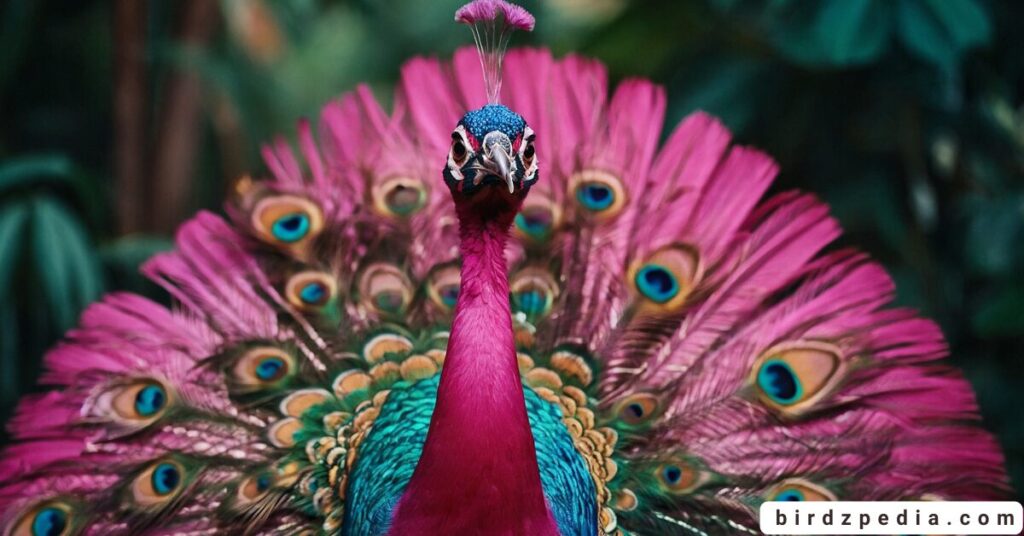
Are there really peacocks pink?
An online fraud known as the “pink peacock“ has been going around for years. Typically, a pink peacock photo is an image of a white peacock with its feathers digitally altered to seem pink. The genetic disorder known as leucism, which results in a partial lack of color, gives rise to white peacocks.
This does not change the underlying color of the feathers, although it can cause white feathers on peacocks. Therefore, beneath the white feathers of a white peacock with leucism, there will be blue or green feathers.
The pink peacock scam most likely originated from the widespread belief that peacocks are beautiful and distinctive emblems. Even more beautiful and uncommon than white peacocks, pink peacocks are sure to catch the eye of some people.
“No, there are no pink peacocks. There are just three natural hues for peacocks.“
- Indian Peafowl (Pavo cristatus)
- Characteristics: Blue and green plumage.
- Green Peafowl (Pavo muticus)
- Characteristics: Mostly green plumage.
- Habitat: Found in Southeast Asia.
- Congo Peafowl (Afropavo congensis)
- Characteristics: Mostly blue plumage.
- Habitat: Found in the Congo Basin.
A Pink Peacock Could Possibly Exist!
A Pink Peacock Could Possibly Exist!
Breeders are always creating new animal variants, while scientists and researchers are always making ground-breaking discoveries regarding species and their genetic variations. It’s critical to comprehend how color pigments affect the hues of peacock feathers in order to assess the prospects for pink
peacocks. Specific pigments and feather structural elements that produce iridescence are what give peacock feathers their brilliant colors. The blues and greens that are characteristic of peacocks are produced by pigments known as carotenoids and melanin in combination with microscopic structures
that scatter light. But the likelihood of a pink peacock depends on the existence of special pigments that may produce red colors, like canthaxanthin or astaxanthin, as well as the particular genetic changes required for these pigments to be expressed in their feathers.
In the field of ornithology and genetic engineering, the appearance of a red peacock is still an intriguing potential even though it might be rare due to genetics and always changing studies.
And let’s talk more about other color peacocks if you’re interested in learning more about them.
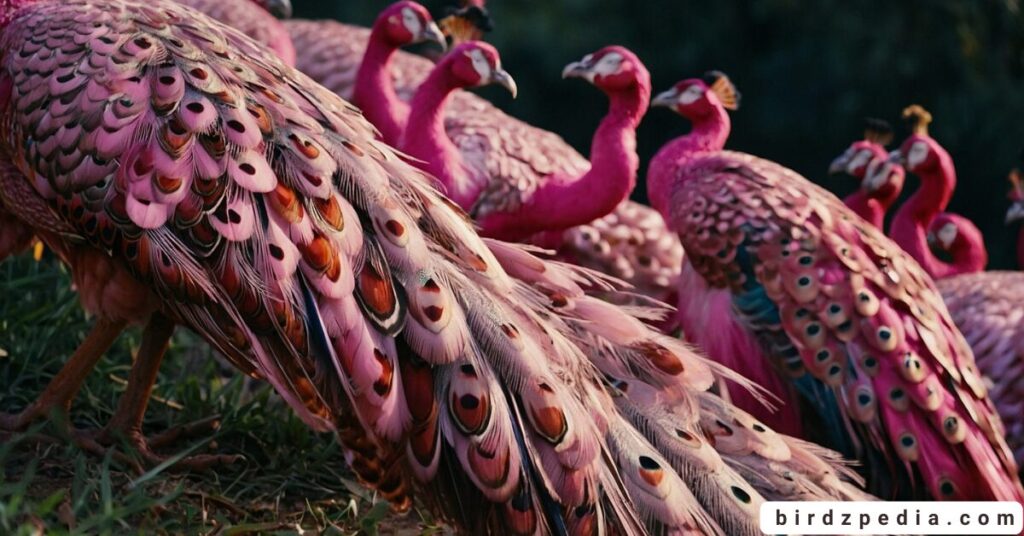
Key Conclusion
- Peach-colored peacocks are the closest thing to pink peacocks in the wild.
- Images of pink peacocks that are shared online are frequently boosted or altered.
- There is no hard proof of sightings of pink peacocks or genetic records.
- Keep an open mind about any future scientific findings that could identify distinctive bird colors.
- Enjoy the diversity and inherent beauty of peacocks in their current color and pattern variations.
Peacock Species
I assume you are aware that the popular term for both male and female birds is peafowl. Additionally, females are referred to as peahens and males as peacocks. Peachicks are the young peafowls. Peacocks are more well-liked because of their stunning long upper tail covert, commonly known as “train,” greater
stature, and characteristic loud call. They are flying birds that are found in forests, fields, and occasionally even urban settings, despite the fact that their train is roughly 5–6 feet long and appears heavy. There are three different species of peafowls: Indian peafowl, green peafowl, and Congo peafowl, despite the latter being more common.
Indian Peafowl (Pavo Cristatus)
- Peacocks: Length: 100-115 cm (39-45 in) with a 195-225 cm (77-89 in) train
- Weight: 4-6 kg (8.8-13.2 lb)
- Peahens: Length: 95 cm (37 in)
- Weight: 2.75-4 kg (6.1-8.8 lb)
One of the most widespread peafowls in the world is the Indian Peafowl. It is indigenous to the Indian subcontinent and is also known as the “Blue Peafowl” or the “Common Peafowl”. Iridescent blue is the peacock’s predominant hue, as its name suggests.
| Aspect | Peacock | Peahen |
|---|---|---|
| Color | Blue and green plumage; long colorful train | Brown head, white cheeks, iridescent green upper necks |
| Train | Present | Absent |
| Courtship | Unique dance with raised feathers to attract peahens | – |
| Diet | Omnivorous, eat various foods including insects and seeds | – |
| Habitat | Originally from India and Sri Lanka, now worldwide | – |
| National Bird | – | India |
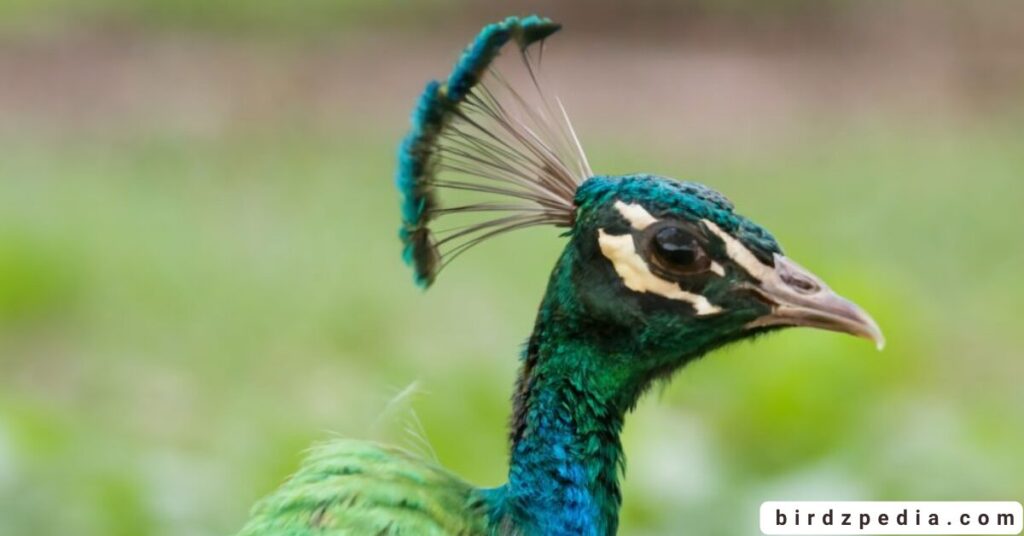
Green Peafowls (Pavo muticus)
Another name for green peafowls is “Indonesian Peafowl.” Southeast Asia is where they originated. They are considered the national bird of Myanmar and are widespread across most of Southeast Asia.
- Both sexes have long upper-tail covert feathers; males extend up to 2 m (6 ft 7 in) with eyespots, females have shorter green coverts covering the tail.
- Exotic and rare peacock.
- Beautiful blue and green feathers that contrast with a black tail and throat.
| Aspect | Green Peafowl |
|---|---|
| Habitat | Preferred habitat includes tropical and subtropical forests; also seen around savannas, grasslands, scrub, and farmland edges |
| Appearance | Green peacocks and peahens are similar, both with iridescent green necks and breasts; peahens have a shorter train covering the tail |
| Sex Identification | Difficult during non-breeding season as male’s train is molted; both sexes look similar in the field |
| Subspecies | Three similar subspecies recognized: Java peafowl, Indo-Chinese peafowl, and Burmese peafowl |
| Conservation | Considered endangered since 2009 on the IUCN Red List due to habitat loss and hunting |

Congo Peafowl (Afropavo Congensis)
“African peafowl” is another name for the Congo peafowl. They are the only native peafowl in Africa out of three kinds, and they are mostly found in the Congo Basin.
- Peacock that is different and unique.
- lives in Central Africa’s thick jungles.
- Feathers of deep blue and copper complement the verdant forest surroundings.
| Aspect | Congo Peafowl |
|---|---|
| Appearance | Males: Red throat skin, white crest, iridescent blue breasts/lower parts, mix of green/blue/violet feathers, distinctive white crest; Females: Mainly brown feathers, black lower body with green flecks |
| Diet | Omnivores; primarily eat fruits and insects |
| Habitat | Mainly inhabit Lowlands forests of Congo |
| Conservation | Considered vulnerable on the IUCN Red List |

Peacocks of Different Colors
There are fifteen different color variants of peafowl, despite the fact that there are only three peafowl species in the globe. Genetic mutation of naturally occurring species results in different hue variants. Numerous color variations in peacocks are also a result of their varied breeds being bred for the pet trade.
- Peacock color classification primarily relies on neck color, with blue and green being the main categories, alongside 13 other colors such as purple, peach, and white.
- All non-blue or green peacocks are mutations of the Indian peafowl.
- Peafowls also differ in body patterns, contributing to their overall appearance diversity.
- With three species, 15 colors, and 5 body patterns, there are 225 recognized peafowl varieties listed by the United Peafowl Organization (UPO).
“These fifteen color peacocks are: Midnight, Jade, Taupe, Hazel, Indigo, Blue, Green, Purple, Peach, White, Cameo, Charcoal, Opal, Buford Bronze, and Sonja’s Violeta.“
Are the Feathers of female Peacocks Colorful?
We discuss about peahens extremely rarely, and mostly about peacocks. Peahens are exquisite birds as well. However, peacocks eclipse them. Thus, it is reasonable to wonder if female peafowls are as colorful as peacocks.
Though I did touch on peahen appearances in my discussion of the three kinds of peafowl, this is the whole comparison.
| Characteristic | Peacock (Indian) | Peahen (Indian) | Peacock (Green) | Peahen (Green) | Peacock (Congo) | Peahen (Congo) |
|---|---|---|---|---|---|---|
| Color (neck) | Blue | Green | Green | Green | Deep blue mixed with green | Chestnut |
| Body Color | Head and neck feathers metallic blue | Reddish-brown head, metallic green lower neck | Emerald green | Dull green (slight mix of brown) on head and body | Red bare skin throat, bronze-green body with black lower parts | Brown feathers, black lower body decorated with green flecks, metallic green back |
| Length | 84 – 96 inches (including train) | About 37 inches | 72 – 120 inches (including train) | 39 – 45 inches | 25 – 28 inches | 24 – 25 inches |
| Train | Upper tail covert | None | Upper tail covert | Short train extending just beyond the tail | None | None |
| Tail | Dark brown | Dark brown | N/A | N/A | Black with blue and green tips | Black with green tip |
| Crest | Fan-shaped crest with black shafts ending in bluish-green webbing | Similar to male but edges are green | Thinner and taller shafted crest | Wider shafted crest | Front part: long white bristles, back part: short and black | Short reddish brown chestnut feathers |
Therefore, it is evident from the comparison above that peahens are just as colorful as peacocks. However, they lack the train, which is a peacock’s most desirable characteristic. Unlike males, female peahens lack the lengthy upper tail coverts, sometimes known as trains. However, we can only see a brief train covering their tails in green peahens.
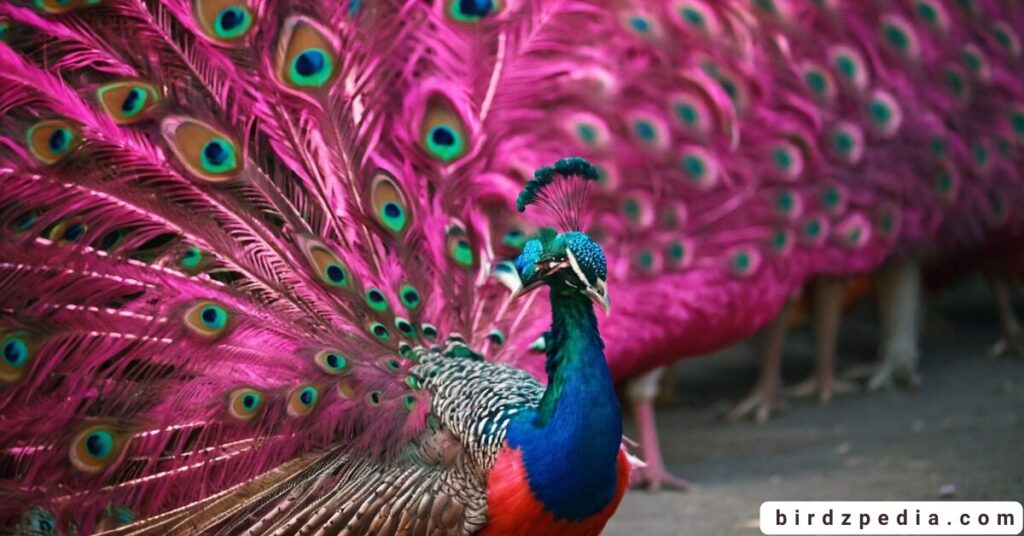
Importance of Pink Peacock
In Fairy Tales:
- Pink-feathered peacocks, though non-existent in reality, play significant roles in fairy tales.
- Their magical and elegant appearances contribute to the allure of these stories.
- Their rarity in reality makes them unique and adds to their enchantment in fairy tales.
- Vibrant colors symbolize good luck, protection, beauty, and happiness in these tales, enhancing their charm.
In Cartoons and Movies:
- Pink peacocks are common in cartoons and movies, portraying beauty, companionship, and magic.
- They stand out with their attractive appearance, teaching the value of being different.
- Their presence emphasizes the beauty and uniqueness found in diversity.
- Pink-feathered peacocks often symbolize femininity, adding depth to characters in movies and cartoons.
What Is The National Bird Of India
The peacock is the national bird of India. Pavo cristatus is the peacock’s scientific name. It is a medium-sized, colorful bird that can be found in portions of Europe, Africa, and Asia. The magnificent tail feathers of peacocks, which may reach a length of three feet, are well-known. In courtship displays, the male’s tail
feathers can fan out to provide an impressive display that is guaranteed to attract any prospective mate. The peacock, commonly referred to as the “Tree of Life,” is the national bird of Sri Lanka. Hindu mythology links the peacock to Lakshmi, the goddess of prosperity and fortune. Because of this, it is regarded as a lucky bird and is frequently kept as a pet in Indian households.
Various Cultures Myth:
The peacock pink is revered as a mythological creature with alluring beauty and symbolic meaning in many civilizations throughout the world. Seven myths are connected to the pink peacock in various religious systems.
Islam
- In Islamic faith, the pink peacock is linked to paradise.
- Reminiscent of lush gardens and beautiful flowers, it symbolizes the abundance and splendor of paradise.
- symbolizes transcendence and spiritual elevation because it can soar far above the surface of the planet.
Hinduism
- connected to Saraswati, the goddess of arts, music, and knowledge.
- represents originality, insight, and artistic expression.
- With their vivid feathers, peacocks stand for creativity and intellect.
Christianity
- In Christianity, the pink peacock represents the Holy Spirit.
- The shimmering feathers stand for the radiance and transformational power of the Holy Spirit.
- The regenerative power of peacock feathers symbolizes rebirth and resurrection.
Chinese
- connected to the legendary bird Fenghuang in Chinese legend.
- Fenghuang is a symbol for prosperity, harmony, and peace.
- It is said that feathers have magical properties that protect people from harm and bring them happiness.
Buddhism
- The pink peacock is a symbol of awakening and enlightenment in Buddhism.
- The five skandhas, which are the essential components of experience and personality, are represented by the feathers of the peacock.
- Feathers’ capacity to grow back and shed represents the cycle of rebirth and metamorphosis.
Native American
- symbolic and connected to rebirth and metamorphosis in many Native American cultures.
- The peacock’s feathers represent life, death, and rebirth as they shed and develop new ones.
- Bright feathers stand for energy, beauty, and a connection to the natural world.
African
- Linked to authority and nobility in African folklore.
- emblem of authority, knowledge, and leadership.
- The metaphorical ability of peacocks to soar above the ground represents the divine link of kings and rulers.
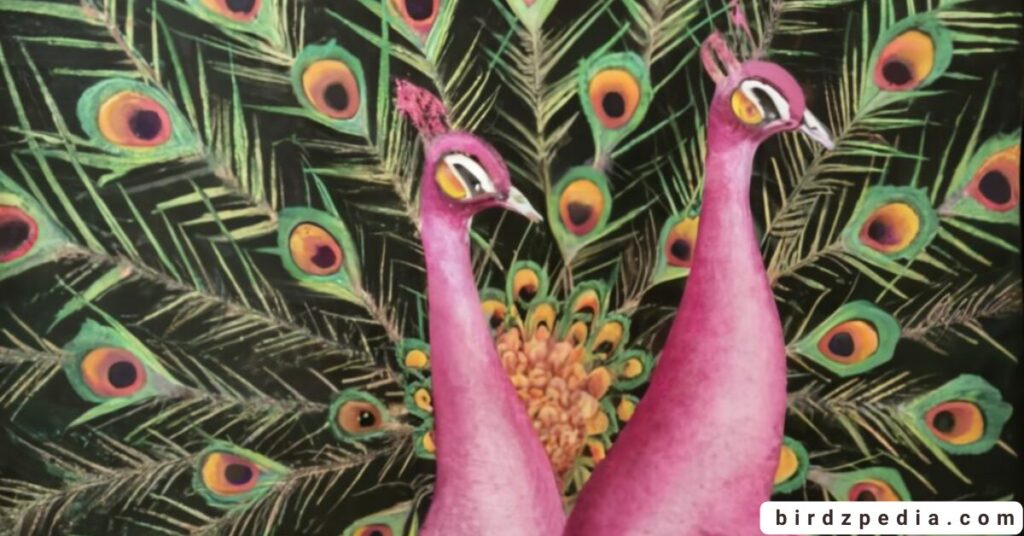
Places That Are Essential to See If You Love Peafowl
Are you a fan of peafowls and can’t wait to see these magnificent animals in their native environment? You only need to look at these premier sites!
Jurong Bird Park
- Jurong Bird Park is Located in Singapore
- Among the biggest and most spectacular bird parks in the world
- More than 600 different bird species call this place home.
- includes a range of peafowl colors and variations.
- Explore the lush, exotic landscapes of the park and admire the stunning plumage of the peacocks.
San Diego Zoo
- situated in California
- One of the most well-known and well-liked zoos in the world has a sizable and varied collection of animals.
- includes the free-roaming peafowls on the zoo grounds
- Visit for a diverse population of peafowl including Indian, green, and white species, showcasing their natural beauty.
Lahore Zoo
- Situated in Pakistan, to be precise.
- Significant historically: One of South Asia’s biggest and oldest zoos.
- A vast array of animals can be found in the Diverse Collection.
- Symbol of the City: The homes of the peafowls that are thought to represent the city.
Exotic Locations
| Country | Peacock Species | Peacock Habitat and Sightings |
| India | Indian Peafowl | I was walking around freely in villages, temples, and national parks. |
| Thailand | Green Peafowl | in natural areas or places that are guarded from poaching. |
| Congo | Congo Peafowl | These uncommon birds live in the deep rainforests. |

There is No Threat Or Danger To Them ?
Peacocks are not regarded as a threatened or endangered species. Actually, they are rather common across their natural habitat. Peacocks come in a variety of color morphs, including albino, white, black-shouldered, and melanistic (all black), as well as pink albino peacocks.
The India blue peacock is the most prevalent and well-known. There are, nevertheless, a few extremely uncommon hue variations, such as the pink peacock. These are difficult to replicate and extremely unusual or rare.
Revealing the Truth
The Existence of Peacocks Pink Rethought. We have looked at the potential and supporting data for the presence of pink peacocks. It is evident that they are unlikely rather than impossible. We now know that they are manmade rather than natural. We now know that they are genuine and not mythological.
Savoring the Beauty of Peafowls in Every Shade We may still enjoy the beauty of peafowls in all their colors even though the identity of the Pink Peacock may never be known. They are deserving of our attention and appreciation because they are some of the most magnificent and graceful animals on the planet. They are a natural gift that we ought to treasure.
Summary
It is now evident that breeders intentionally produce pink-feathered peacocks rather than allowing them to naturally occur. The majority of pink peafowl videos and pictures on social media are bogus. Cartoons, movies, and fairy tales all frequently touch on them. They are lovely beings that represent feminism, magic, and beauty. They also bring good fortune. In order to generate them, the breeders first select a white baby peacock, color or dye it red, and then combine the red and white colors to get the pink hue.
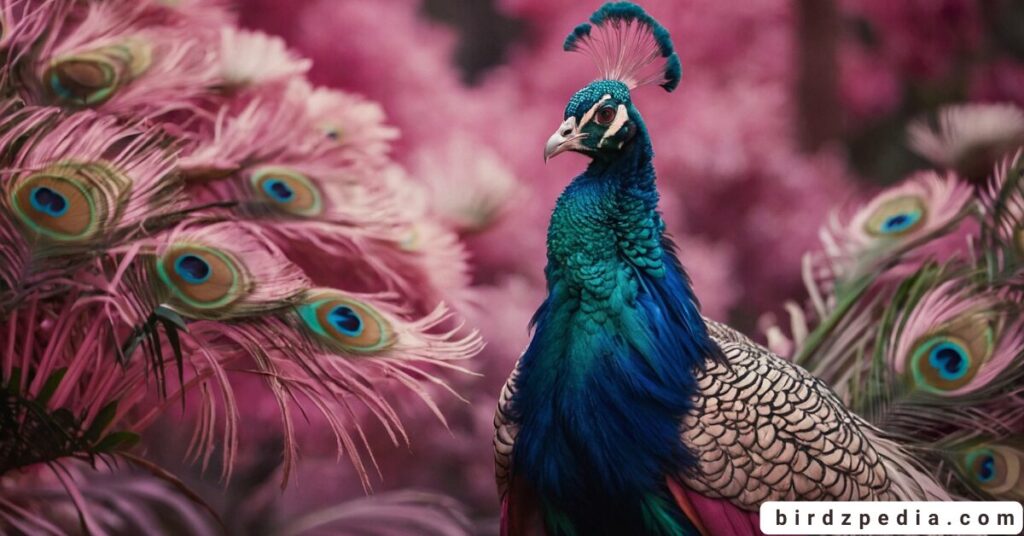
FAQs
- Do pink peacocks exist in nature?
- No, there aren’t any in the wild. Peacocks do, however, appear in color variations that are nearly pink, such as peach.
- What distinguishes a white peacock from a pink peacock?
- A white peacock is a genuine genetic mutation; a pink peacock is a fake. Pink peacocks have pink feathers because of a distinct genetic mutation, whereas white peacocks have white feathers because of a lack of pigment.
- Why do pink peacocks not exist in the wild?
- The absence of pink peacocks in the wild can be attributed to a number of factors. The incredibly unusual nature of the genetic mutation that results in pink feathers is one explanation. Predators would find pink peacocks to be easy prey since they would be highly visible and noticeable. This is another reason.
- Is it possible to artificially breed pink peacocks?
- Pink peacocks can indeed be produced artificially by breeding. One way to achieve this is to cross two peacocks that have distinct mutations affecting the color of their feathers. For instance, a pink peacock might result from mating a peacock with a red mutation and a white mutation.
- For what duration have pink peacocks been extant?
- For many years, the pink peacock hoax has been going around the internet. It looks like the first documented photo of a pink peacock dates from 2004.
- Which 15 colors are there in the peacock?
- The peacock is colored in tones of gold, white, green, and blue. The peacock’s magnificent plumage is created by the combination and variety of various hues, even if there may not be precisely 15 distinct colors.
- Where can we view peacocks of various colors?
- Peacocks of various colors can be found in some zoos and breeding farms. Green and Congo peafowls are less numerous and have dispersed habitats, whereas Indian peafowls are the most abundant and can be spotted everywhere.
- Why do pink peacocks pique people’s interests so much?
- Peacocks are frequently seen as emblems of elegance and exclusivity. Some people are probably drawn to the concept of a pink peacock, which is even more exquisite and uncommon than a white one.
- What does a pink peacock symbolize?
- Many people associate the pink peacock with femininity, passion, and love. It may also represent imagination, inventiveness, and fresh starts.
- Are the feathers of female peacocks colorful?
- No, unlike their male counterparts, female peacocks, often known as peahens, lack the vivid feathers. For camouflage, their plumage is more modest, primarily brown, gray, or white.
- What distinguishes peahens and peacocks from one another?
- Male peacocks exhibit elaborate courtship displays, a lengthy train of iridescent feathers, and vivid blue and green feathers. Brown heads, white cheeks, iridescent green necks, and brown plumage are characteristics of female peahens. Unlike peacocks, peahens lack the lengthy train feathers.
- What are some ways to identify a phony pink peacock photo?
- To determine whether a picture of a pink peacock is phony, there are a few indicators you can check for. The image’s quality is one thing to check. Pink peacock fake pictures are frequently distorted or fuzzy. The color’s uniformity is something else to check for. The pink peacock in the picture need to remain the same hue the whole time.
- What other common misunderstandings exist regarding peacocks?
- Other common misperceptions regarding peacocks are that they are exclusively found in India, that they are exclusively male, and that they are the only birds with tail fangs.
- What is the number of peacock species?
- The Indian peafowl, green peafowl, and Congo peafowl are the three primary species of peafowls.
- Where can I find more information on peacocks?
- You may get a wealth of information about peacocks through several resources. The websites of Cornell Lab of Ornithology, National Geographic, and the Audubon Society all have information.


![Pelagic cormorant: [Urile pelagicus] Odyssey Habitat, and Overview](https://birdzpedia.com/wp-content/uploads/2024/01/Channel-Billed-Toucan-1-768x402.png)

![Toco Toucan[: Ramphastos toco] Overview, Habitat, Diet, Sounds](https://birdzpedia.com/wp-content/uploads/2023/12/Toco-Openbill-768x402.png)

![Red-Breasted Toucan: [Ramphastos dicolorus] A Symphony of Colors](https://birdzpedia.com/wp-content/uploads/2024/01/Red-breasted-Toucan-768x402.png)
![Yellow-Throated Toucan [Ramphastos ambiguus]: Habitat, Diet, Sounds, Overview](https://birdzpedia.com/wp-content/uploads/2023/12/Add-a-heading-768x402.png)